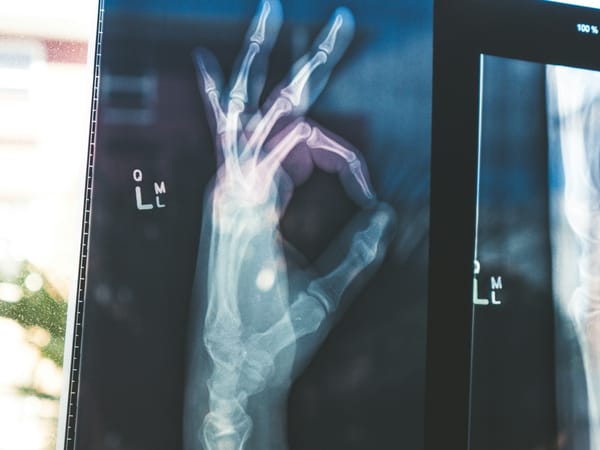The Complete Guide to Retrospective Investigator Sponsored Trials
An exhaustive overview of conducing retrospective investigator sponsored trials.

Conducting clinical research at your private practice sounds exciting, doesn't it?
However, being a part of a large multi-center clinical trial on a pivotal new drug or device can be daunting if you are unfamiliar with clinical research.
To get your feet wet in clinical research, the best place to start is a retrospective study.
This article will outline how, as well as the advantages and disadvantages of this type of study.
Let's dig in.
What is a Retrospective Trial ⁉️
Let's first define what a retrospective study is.
A retrospective trial, as the name implies, looks backwards at data that has already been collected.
Having a private practice means that you are already sitting on a mountain of data from your patients. However, because this is patient data you will need to properly conduct the clinical trial and especially have ethical oversight from an institutional review board (IRB) or research ethics board (REB).
How to Conduct a Retrospective Study 🔬
There are generally 5 key steps for any clinical trial, and a retrospective study is no different. These are DESIR:
- Design - Plan the clinical trial and secure funding
- Ethics - Prepare all necessary documentation for IRB/REB submission and approval
- Study - Conduct the clinical trial
- Investigate - Analyze the collected data
- Report - Publish results at conferences and in peer-reviewed articles
Let's review these in more detail.
Step 1: Design ⬜
At this stage you will formulate your research question, choose the type of study, and secure funding (if needed).
Determine a Research Question
The first step to design a retrospective study is to figure out what research question you want to answer. A good place to start is to investigate what is already published to see if you can identify a gap in the literature.
Blehm C, Hall B. Comparing predictive accuracy of a swept source optical coherence tomography biometer and an optical low coherence reflectometry biometer. Clinical Ophthalmology 2023;17:2125-2131.
You can start by reading the top 3 medical journals in your field to get your creative juices flowing.
Here are also a few prompts to consider:
- A new drug or device become available and you want to report on the clinical outcomes from your practice.
- You have a unique patient population (long term outcomes with drug/device, age, race, environmental conditions).
- You have a large amount of data on a particular outcome.
Next, head on over to PubMed and double check that your study idea has not already been published. If it has, keep iterating with reading journal articles and coming up with ideas. Eventually, you will find your big idea.
While you are coming up with ideas, keep in mind what data you collect and retain as part of your standard of care. Having a research question is no good if you don't routinely collect the data to answer it!
Choose your Type of Study
The data has already been collected, so you won't be able to have a prospective, randomized, double-blind study. However, there are a couple other study types to consider.
- Study Arms - Will there be a single arm (one group) or multiple arms (multiple groups)?
- Study Sites/Investigators - Will you be pulling data only from your patient population or will you bring in other investigators from your or other practices?
Secure Funding
Though this is an investigator sponsored trial you can still apply for and use grant funding to pay for the research activities.
The easiest place to secure funding is from you! You can complete a retrospective trial for as little as a few thousand dollars if you do most of the work yourself. This is the fee you will pay for ethical oversight.
Another good source of funding is the manufacturer of the drug/device in your study design. Favourable results for their product can be a great marketing asset for the company. Reach out to them and pitch your study idea.
Other sources of funding include local, state/provincial, and federal government research grants, but the timeline from application to eventual funding can take a long time. These can also be quite competitive.
As you read through papers from medical journals in your field make note of the funding disclosures in the articles you read and see if your practice and study would qualify.
Step 2: Ethics 🥼
Any study using data from humans will need ethical oversight from an IRB or REB.
But you may be wondering, "Do I really need approval if there is no medical treatment and the data has already been collected?"
Yes!
For a retrospective chart review, the IRB/REB will likely determine that the research is exempt from ongoing IRB oversight, but only the IRB/REB can make that determination.
The IRB/REB will also need to grant a waiver of informed consent before you can review the charts. Without it, each subject will need to consent before you can use their data.
You will need to prepare essential documents and submit for approval.
Prepare Essential Documents
Compared to a prospective study there are less documents to prepare for approval, but there are still a few key ones.
- Protocol - A study protocol is a formal representation of your study design that you created in Step 1: Design. It contains background information, the research question you want to answer, and what and how much data you will collect to help answer that question.
- Curriculum Vitae - An overview of your education, experience, previous clinical trials, and publications.
- Medical License - A copy of your medical license.
- Good Clinical Practice Training - A copy of a training certificate showing that you have completed GCP or human subjects research training.
Submitting for IRB/REB Approval
After you have prepared the necessary documents for submission, there will still be a number of forms to complete for the IRB/REB.
- General information about the study including if it includes any vulnerable populations.
- Your experience as an investigator.
- Your justification why the study is minimal risk.
- Your plan to protect confidentiality of patient data (i.e. de-identify the data and not collect protected health information).
- Request for waiver of informed consent.
- Advarra
- SalusIRB
- SterlingIRB
- WCG IRB
If you are a new client you may have to prepay the IRB/REB fee upfront before review. The cost is generally between $1,000 and $2,000, but varies between different providers.
After the application is submitted, the IRB/REB may have clarification questions before official review. After official review, you should have your approval and can move on to the next step.
Step 3: Study 🗒️
With approval, you can mine through your data and pull out what is relevant to the study.
If your data is primarily in patient charts then you are going to need to create a spreadsheet and transcribe in the key information. If you are short on time, this is a good task for staff to complete.
You, of course, want all data related to your study questions and endpoints, but don't neglect demographic information as well. For example, age, sex, race, and refraction might be important.
I recommend to look at similar articles that have been published in the top medical journal in your field and see what kind of demographic information is being collected. Make sure that you transcribe similar information.
Now, if you have electronic health records it may even be easier to grab the data if you can mass export. Though you may need support from your IT staff to complete this.
Data may also be able to be mass exported from diagnostic equipment or surgical suite software.
Make sure you don't export personal health information such as names, birth dates, addresses, email addresses!
Step 4: Investigate 📊
Once all the data is collected in a spreadsheet and somewhat organized, now the fun part begins!
The simplest analysis is for a single-arm descriptive study. This involves only doing descriptive statistics: mean, median, standard deviation, percentages, etc.
What you report will depend on the data. Continuous data is usually summarized as mean with standard deviation. Survey data, especially data from non-validated surveys is better summarized using percentages. For example, 47% of participants selected Yes on the survey at Visit 1 compared to 78% at Visit 2.
Simple statistics like this can generally be completed in most spreadsheet software without the need for statistical software.
However, inferential statistics will generally require more robust software, though unless you are very comfortable with statistics, you should hire a biostatistician for this part.
There are a lot of mistakes that can be made. Statistical tests have assumptions that must be met before you can use them. If you blindly use a test without validating the assumptions, the answer you get will be wrong.
Garbage in, garbage out.
Here is an example.
Everyone loves to do a t-test, but not everyone checks the 4 underlying assumptions:
- The distribution of the data is close to normal
- The variability of the data is similar between groups
- Data have been randomly selected from the population
- Data are continuous
Once the data analysis is complete, you can breathe a sigh of relief and move on to the next step.
Step 5: Report 📝
The ultimate aim of most studies is to publish the results!
This is generally in a peer-reviewed medical journal.
Preparation of Manuscript
This type of specialized writing can be outsourced to a designated medical writer, but here are the general 4 parts of a paper.
- Introduction - the problem, why it is relevant, and what question you are trying to answer.
- Methods - how you investigated the research question.
- Results - what you uncovered.
- Discussion - why your findings are relevant and how they compare to and expand current understanding.
Submitting a Manuscript
When the manuscript is written you will need to submit it to your target journal through their online portal.
Pay special attention to any "Instructions for Authors" as each journal has their own requirement. Failure to do so will only cause delays and may cause outright rejection.
Peer-Review
If your article makes it past editorial checks it will be sent for review by your peers. These anonymous reviewers assess your study design, in addition to the actual manuscript, to see if it adds anything to the body of knowledge.
The reviewers send their recommendations to the editor, who makes the final decision to reject or require revisions.
Revisions are meant to satisfy any holes poked in your study or writing by the reviewers. When the reviewers and editors are satisfied, your article will be accepted.
Congratulations, you are now a published author in a medical journal!
What are the Advantages of a Retrospective Study 👍
A retrospective study is not inherently better or worse than a prospective study, but it is different.
There is no right or wrong choice, only trade-offs.
Here are a few advantages to a retrospective study compared to a prospective study.
Simplicity
You might be thinking, "A retrospective study is hard to execute."
However, if you follow the action steps, above it is really quite simple.
Just follow the framework DESIR and you will be successful.
Speed
A retrospective study is quick to start and complete because the data is already collected.
All you need is permission from an ethics board or institutional review board to analyze the data and waive informed consent. Then you are off to the races.
Cost
If you want to do most of the work yourself, the only cost is the IRB cost.
It is pretty cheap to run compared to a prospective study. With a prospective study you are going to need to pay your staff extra to do the extra data collection and you should compensate patients for being in the study and attending study visits.
What are the Disadvantages of a Retrospective Study 👎
On the flip side, here are a few disadvantages to a retrospective study compared to a prospective study.
Less Impact than a Prospective Study
With a retrospective study, the impact is lower than a prospective study, especially because there's not really a way to randomize because the data is already collected.
Even if you had a comparator group, it's less impactful than if you had a randomized study with two groups and patients are randomized into one or the other group.
Limited by Data Collected
You can also investigate what you already collected.
If you are missing a certain piece of data or you used a non-standardized questionnaire it will impact your study. Also, perhaps it is more impactful to collect data for up to 1 year post-intervention and you only have data for 3 months.
Summary
This article has summarized retrospective studies, including a framework to being and complete a retrospective trial from design to publication. Starting with a retrospective study is a great place to get your feet wet. You can start getting familiar with the research process and start getting your head into the space of clinical research.
If you found this information useful, please consider sharing. If you want more of this content, please consider subscribing. If you have insights of your own please consider reaching out to me. Get in touch!




